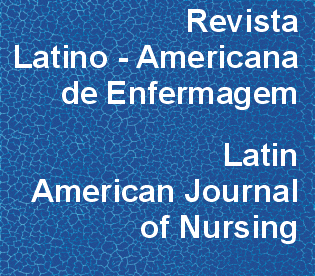Prevalence of household falls in long-lived adults and association with extrinsic factors
DOI:
https://doi.org/10.1590/1518-8345.1646.2900Keywords:
Aged, 80 and Over, Accidental Falls, Risk Factors, NursingAbstract
Objective: to identify the prevalence of falls among older adults and the extrinsic factors associated with them. Method: population-based cross-sectional study with 350 older adults. A household survey was conducted using a questionnaire addressing socio-demographic, clinical, and environmental characteristics. Data were analyzed using Stata Software V.10. Pearson’s chi-square test and logistic regression analysis were used with stepwise criteria for selection of variables in the model, with measures of effect expressed in Prevalence Ratio. For input into the multiple model, the variables with p ≤ 0.20 were considered. All ethical care regarding research on human beings has been observed and respected. Results: the prevalence of falls was 46.9%. The extrinsic factors associated with falls were: stairs, uneven floor and pets in the main entrance, lack of anti-slip loose throw rugs and slippery floor in the kitchen, lack of anti-slip loose throw rugs and objects on the floor in the room, lack of grab bars in the shower, lack of grab bars in the toilet and switch away from the bathroom door (p <0.05). Conclusion: falls are frequent in long-lived adults. The identification of the extrinsic factors associated with the occurrence of this event can help in its prevention.Downloads
Download data is not yet available.
Downloads
Published
2017-01-01
Issue
Section
Original Articles
License
RLAE’s authorship concept is based on the substantial contribution by each of the individuals listed as authors, mainly in terms of conceiving and planning the research project, collecting or analyzing and interpreting data, writing and critical review. Indication of authors’ names under the article title is limited to six. If more, authors are listed on the online submission form under Acknowledgements. The possibility of including more than six authors will only be examined on multicenter studies, considering the explanations presented by the authors.Including names of authors whose contribution does not fit into the above criteria cannot be justified. Those names can be included in the Acknowledgements section.
Authors are fully responsible for the concepts disseminated in their manuscripts, which do not necessarily reflect the editors’ and editorial board’s opinion.
How to Cite
Pereira, S. G., Santos, C. B. dos, Doring, M., & Portella, M. R. (2017). Prevalence of household falls in long-lived adults and association with extrinsic factors. Revista Latino-Americana De Enfermagem, 25, e2900-. https://doi.org/10.1590/1518-8345.1646.2900



